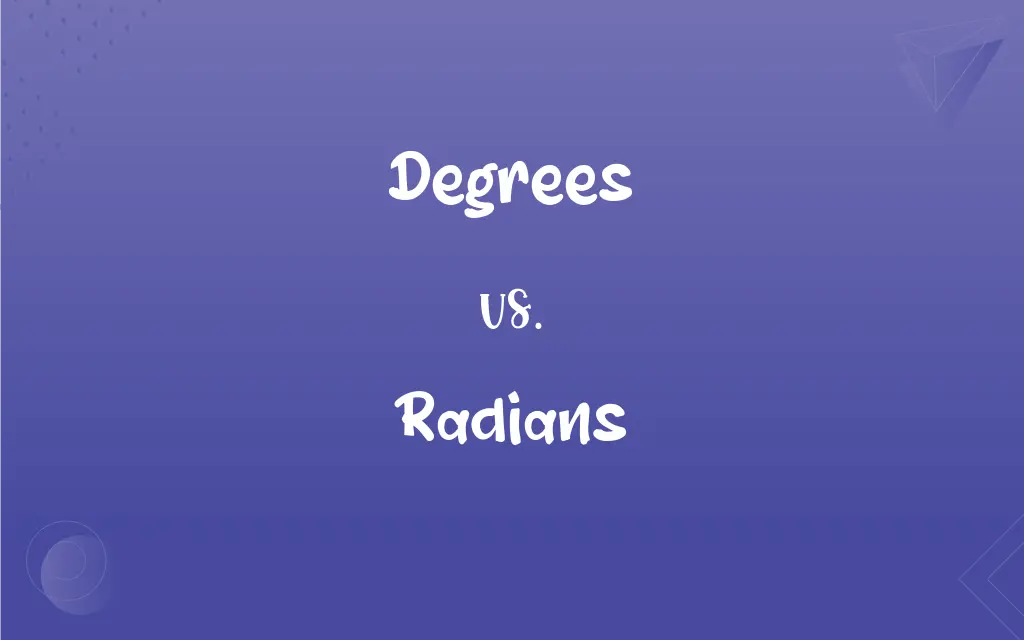Degrees vs. Radians: What's the Difference?
Edited by Aimie Carlson || By Harlon Moss || Published on January 25, 2024
Degrees and radians are two units for measuring angles; degrees divide a circle into 360 parts, while radians use the radius to measure around a circle, equating to about 57.3 degrees.

Key Differences
Degrees are a measure of angles where a full circle is divided into 360 equal parts. Each part is one degree. In contrast, radians offer a different approach, defining angles based on the radius of the circle. One radian is the angle created when the arc length equals the radius.
The concept of degrees is historically older and more familiar in everyday contexts. It is widely used in various fields like navigation and geometry. Radians, however, are more common in higher mathematics and physics as they provide a direct relationship between the angle and the arc length.
When measuring in degrees, simple fractions of a circle, like a quarter or half, are easily represented (90° and 180°, respectively). Radians, on the other hand, express these fractions in terms of π, with π radians being equivalent to 180 degrees, making them more intuitive in mathematical analysis.
In practical applications, degrees are often preferred for their simplicity and ease of understanding. Radians, however, are essential in calculus and trigonometry, as they simplify the integration and differentiation of trigonometric functions.
To convert between degrees and radians, one can use the relation 180 degrees equals π radians. This conversion is crucial in various scientific and engineering fields where both units are used interchangeably.
ADVERTISEMENT
Comparison Chart
Unit Definition
1/360 of a circle’s circumference
Angle subtended by an arc equal to the radius
Historical Origin
Ancient civilizations’ use of 360-day calendars
Conceptualized in 18th century mathematics
Use in Mathematics
Common in basic geometry and navigation
Essential in advanced mathematics, like calculus
Relationship to π
No direct relationship
Directly related (π radians = 180 degrees)
Conversion Factor
1 degree = π/180 radians
1 radian = 180/π degrees
ADVERTISEMENT
Degrees and Radians Definitions
Degrees
A level or step in a scale, often used to denote intensity or severity.
The illness escalated to a dangerous degree.
Radians
A dimensionless unit, derived from the ratio of two lengths.
Radians simplify the formulas in circular motion.
Degrees
A stage in a process or series.
The project is in its final degrees of completion.
Radians
A unit of angular measure where the angle subtended at the center of a circle is equal to the radius.
In trigonometry, π/2 radians represent a right angle.
Degrees
A measure of temperature.
The temperature dropped to 30 degrees overnight.
Radians
A measure used in mathematics to relate the length of an arc to its radius.
A full circle is 2π radians.
Degrees
A unit for measuring angles, one degree is 1/360 of a circle's circumference.
The corner of a square measures 90 degrees.
Radians
A standard unit in calculus for differentiating and integrating trigonometric functions.
The derivative of sin(x) is cos(x) when x is measured in radians.
Degrees
An academic award conferred by a university or college.
She earned her degree in biology.
Radians
A unit used in physics to describe rotational motion.
Angular velocity is often expressed in radians per second.
Degrees
One of a series of steps in a process, course, or progression; a stage
Proceeded to the next degree of difficulty.
Radians
A unit of angular measure equal to the angle subtended at the center of a circle by an arc equal in length to the radius of the circle, approximately 57°17′44.6".
Degrees
A step in a direct hereditary line of descent or ascent
First cousins are two degrees from their common ancestor.
Radians
Plural of radian
FAQs
Can degrees be converted to radians?
Yes, degrees can be converted to radians using the formula 1 degree = π/180 radians.
What is a degree?
A degree is a unit of measurement for angles, representing 1/360 of a circle.
Are radians more complex than degrees?
Radians can seem more complex due to their mathematical nature, but they simplify many calculations in advanced mathematics.
Are radians used in physics?
Yes, radians are often used in physics, especially in describing rotational motion and wave phenomena.
Why are degrees commonly used in everyday life?
Degrees are simpler and more intuitive for everyday use, like in navigation and basic geometry.
Why are radians preferred in calculus?
Radians provide a natural approach to dealing with arc lengths and simplify the differentiation and integration of trigonometric functions.
How is a radian defined?
A radian is defined as the angle subtended at the center of a circle by an arc whose length is equal to the radius of the circle.
How are angles measured in astronomy?
Angles in astronomy are typically measured in degrees, arcminutes, and arcseconds.
Do all calculators support both degrees and radians?
Most scientific calculators allow switching between degrees and radians.
Do engineers use degrees or radians?
Engineers use both, depending on the specific requirements of their work.
Is it necessary to learn both systems?
Understanding both systems is beneficial, especially in fields involving mathematics, physics, and engineering.
Is there a simple way to remember how to convert between degrees and radians?
Yes, remember that 180 degrees equal π radians.
Is one unit better than the other?
Neither unit is inherently better; the choice depends on the context and application.
What is the significance of 360 degrees in a circle?
The use of 360 degrees is based on historical and practical reasons, likely derived from ancient astronomical observations.
How many radians are there in a full circle?
There are 2π radians in a full circle.
Can understanding radians improve mathematical skills?
Yes, understanding radians can enhance comprehension of higher-level mathematics.
Why is π important in the relationship between degrees and radians?
π is a fundamental constant that relates the circumference of a circle to its diameter, central to converting between degrees and radians.
Are there any angles where degree and radian measurements are the same?
No, due to the different bases of the two systems, no angle will have the same numerical value in both degrees and radians.
Do professionals in different fields prefer different units?
Yes, professionals choose units based on practicality and convention in their respective fields.
Are degrees and radians interchangeable in formulas?
They are interchangeable with proper conversion but using the wrong unit without conversion can lead to errors.
About Author
Written by
Harlon MossHarlon is a seasoned quality moderator and accomplished content writer for Difference Wiki. An alumnus of the prestigious University of California, he earned his degree in Computer Science. Leveraging his academic background, Harlon brings a meticulous and informed perspective to his work, ensuring content accuracy and excellence.
Edited by
Aimie CarlsonAimie Carlson, holding a master's degree in English literature, is a fervent English language enthusiast. She lends her writing talents to Difference Wiki, a prominent website that specializes in comparisons, offering readers insightful analyses that both captivate and inform.
































































